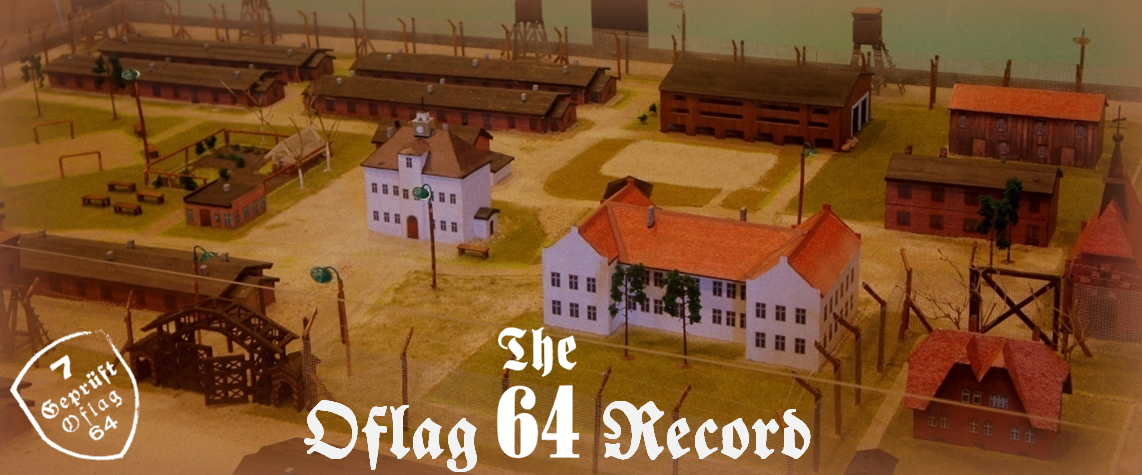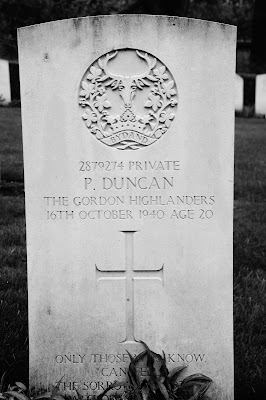W czwartek 21. kwietnia 2016 r. odwiedziłem Cmentarz Wojenny Wspólnoty Brytyjskiej w Poznaniu w celu sfotografowania nagrobków spoczywających tam brytyjskich
jeńców, którzy zmarli w Stalagu XXI-B i Oflagu XXI-B w Szubinie. Ku mojemu zaskoczeniu, tego samego dnia, kiedy wróciłem do domu, w mojej skrzynce pocztowej znalazłem emaila od Billa Robertsona, prawnuka starszego szeregowego Johna Conwaya. Bill przesłał mi skan dziennika wojennego, który należał do jego pradziadka, który był jeńcem w Oflagu XXI-B w Szubinie. W dzienniku tym pośród wielu zdjęć z okresu jego służby wojskowej i niewoli były także zdjęcia dokumentujące pogrzeb podporucznika Petera Lovegrove’a na szubińskim cmentarzu. W uroczystości pogrzebowej z ceremoniałem wojskowym uczestniczyło wielu z jego towarzyszy broni oraz żołnierze niemieccy. Po wojnie jego zwłoki zostały przeniesione właśnie na Cmentarz Wojenny Wspólnoty Brytyjskiej w Poznaniu. Peter, jako jedyny z załogi szczęśliwe ocalał katastrofę swojego samolotu, ale niefortunnie zmarł krótko później w niemieckiej niewoli.
Okazało się, że zaledwie dwa dni później rodzina Petera odwiedziła jego grób w Poznaniu, a kolejnego dnia, w niedzielę, byli także w Szubinie. Niestety nie udało nam się wtedy spotkać. Podczas mojego wykładu pt.:
“Nad i pod drutem kolczastym, czyli znane i nieznane fakty o ucieczkach z szubińskich obozów jenieckich Oflag XXI-B i Oflag 64”, który miał miejsce w Muzeum Ziemi Szubińskiej 26. kwietnia br. wspominałem historię tragicznej śmierci Petera Lovegrove’a ilustrując ją zdjęciami pogrzebu otrzymanymi od Billa Robertsona. Niestety plany rodziny Lovegrove’ów, nie pozwoliły im uczestniczyć w tym wydarzeniu, ale w ostatnim czasie postanowiłem skontaktować się z noszącym imię po swoim wuju bratankiem jeńca zmarłego w szubińskim obozie. Dzięki jego uprzejmości mogłem poznać więcej faktów o nieszczęsnym losie młodego lotnika, który jak opisał w swojej książce pt.: “Moonless Night” Bertram James –
“był członkiem jednostki wywiadowczej opracowującej mapy dla uciekinierów i wykonując zadanie zwiadowcze upadł z wysokości ponosząc śmierć na miejscu”.
***
Peter Anthony Lovegrove, urodził się 3. marca 1920 r. Był pilotem rezerwy, ochotnikiem w stopniu podporucznika (No. 83 Squadron RAF). Jako jedyny ocalały w katastrofie samolotu, która wydarzyła podczas misji na Hamburg w nocy z 8/9. kwietnia 1942 r. trafił do niewoli i od 9. kwietnia1942 przebywał w szpitalu Lazarett Hohe Mark w Dulag Luft. Następnie 28. maja 1942 r. został osadzony w Stalag Luft III w Żaganiu i 17. września 1942 r. przetransportowany do Oflagu XXI-B w Szubinie.
Peter Anthony Lovegrove w galowym mundurze (z archiwum rodziny Lovegrove).
Pośród wielu listów do matki, jedyny wysłany z Szubina z datą 15. października 1942 r. okazał się być ostatnim. Peter pisał:
“Nie dostałem jeszcze nowej odzieży ani paczki medycznej z żywnością , ale podejrzewam, że to opóźnienie powstało w związku ze zmianą obozu, (…) mamy jednak zapasy jedzenia w tym nowym obozie”. Wkrótce jego matka otrzymała wysłany z datą 23. listopada telegram od Czerwonego Krzyża w Genewie, który przyniósł smutną wiadomość, że według oficjalnych doniesień Peter zmarł na skutek upadku z okna 12. listopada 1942 r.
Telegram z Międzynarodowego Czerwonego Krzyża (datowany 23.10.1942) informujący o śmierci Petera (z archiwum rodziny Lovegrove).
Więcej wyjaśnień dotyczących okoliczności przykrego zdarzenia rodzina otrzymała w liście wysłanym wraz z kondolencjami i wyrazami pocieszenia (16.11.1942) od obozowego kapelana: “Niezbyt dobrze znałem Twojego syna, ponieważ jestem tu kapelanem zaledwie od kilku tygodni, ale jego towarzysze wyrażają się on nim bardzo dobrze. Jego doczesne szczątki spoczęły na cmentarzu w Szubinie w Polsce i ja osobiści przewodniczyłem modlitwie nad jego grobem. Pochowano go z honorami wojskowymi. Wielu jego towarzyszy uczestniczyło w tej uroczystości, a salwa honorowa została oddana przez niemieckich żołnierzy. Spoczywa obok innego z jeńców, który zmarł w obozie”. W kolejnym liście (18.03.1943) kapelan napisał: “Twój syn wypadł z okna obozowego szpitala i zginął na miejscu. Sądzi się, że obserwował okolicę szukając możliwości ucieczki i prawdopodobnie stracił równowagę. Istnieje kilka powodów, na podstawie których nasz Starszy Oficer Obozu doszedł do tych wniosków. Z oczywistych powodów nie mogę napisać, o jakie chodzi, ale później, kiedy wrócę do Anglii, będę miał możliwość spotkania się z Tobą i wtedy będę mógł Ci je wyjawić. Mam też kilka zdjęć zrobionych podczas pogrzebu, które również Ci przekażę”.

Budynek byłego obozowego szpitala, z którego dachu (okna) upadł Peter owego pechowego dnia (zdjęcie wykonane przez bratanka Petera podczas jego wizyty w Szubinie w kwietniu 2016 r.).
List Starszego Oficera Obozu, komandora porucznika Harrego Day’a (20.12.1942) opisuje w szczegółach wszystkie okoliczności tragicznej śmierci Petera:
„Jestem Starszym Oficerem Obozu i piszę do Ciebie, żeby Ci powiedzieć, jak bardzo przygnębił nas wszystkich ten straszny i niespodziewany wypadek, który zabrał Twojego dobrze zapowiadającego się i odważnego syna. Znałem go odkąd przyjechał do Stalagu Luft III i już od wtedy miałem o nim jak najlepsze zdanie. Nakazałem podporucznikowi Tench’owi, który znał Twojego syna jeszcze w Anglii, przeprowadzić dokładne śledztwo, w wyniku którego ustalono, że Twój syn wspiął się na okno na trzecim piętrze budynku szpitala o godzinie 14:45, kiedy to stracił równowagę, ześlizgnął się i spadł na chodnik przed wejściem do szpitala. Dwóch oficerów medycznych było akurat w pobliżu i niezwłocznie podbiegli do niego, ale Twój syn zginął na miejscu, ponieważ upadł na głowę. Powód, dla którego Twój syn wszedł na okienny parapet nie jest do końca jasny, ponieważ nikogo przy nim nie było, ale można powiedzieć, że był motywowany chęcią ucieczki. Okno to stanowi dobry punkt obserwacyjny na najbliższą okolicę. Jak zapewne wiesz, Twój syn podjął już raz nieskuteczną próbę ucieczki i jestem przekonany, że wraz z drugim jemu podobnym kompanem, planował następną”.
Matka Petera otrzymała również list od jednego z kolegów Petera. Do listu była dołączona jego ostatnia fotografia, wykonana zaledwie w przeddzień jego śmierci.
“Rankiem w dniu kiedy zmarł, nie czułem się najlepiej i on przyniósł mi śniadanie do łóżka. Wydawało się, że wszystko jest u niego w najlepszym porządku – był miły jak zawsze. Chciałbym odwiedzić Panią po wojnie. Przywiozę dwie fotografie wykonane dokładnie 24 godziny przed jego wypadkiem. Załączam jedną z nich”.
Ostatnia fotografia, na której jest również Peter, wykonana zaledwie 24 godziny przed jego tragiczna śmiercią.
Grupowy portret jeńców Oflagu XXI-B w Polsce, hitlerowskiego obozu dla oficerów.
Od lewej w stoją: Bromiley, Leetham, John Dicker, niezidentyfikowany oficer oraz Organ.
W przednim rzędzie od lewej: Lovegrove, Svenson i niezidentyfikowany oficer(
P02028.049, Original print housed in the AWM Archive Store).
Pożegnanie oficera na szubińskim cmentarzu opisano matce Petera w korespondencji z Czerwonego Krzyża (13.03.1943):
“Pogrzeb z wojskowymi honorami odbył się o 14 listopada o 10:30 na lokalnym cmentarzu. Na miejsce spoczynku odprowadził go Rev McConchie, kapelan sił zbrojnych. W jego ostatniej drodze towarzyszyło mu 30 oficerów wraz ze mną uczestniczyło, a sygnały „Last post” oraz “Reveille” zostały odegrane na trąbce przez jednego z brytyjskich żołnierzy. Niemieccy żołnierze oddali trzy salwy honorowe. Na grobie złożono 6 wieńców, cztery od jego towarzyszy z obozu, jeden od jeńców RAF ze Stalagu Luft III oraz jeden od niemieckiej komendantury obozu. Wieńce wykonane były z kalii i gałązek świeżych iglaków. Podporucznik Lovegrove spoczął obok porucznika Edwardsa, który nieszczęśliwie został zastrzelony kilka tygodni temu podczas próby ucieczki. Groby innych brytyjskich, francuskich i polskich żołnierzy są zadbane. Cmentarz znajduje się w zacisznym miejscu poza miastem i są na nim posadzone drzewa. Podporucznik Lovegrove spoczywa w towarzystwie, nie można zatem powiedzieć, że jest sam”.

Zdjęcia pogrzebu wysłane rodzinie Petera z Oflagu XXI-B.
Nagrobek Petera na Cmentarzu Wojskowym Wspólnoty Brytyjskiej w Poznaniu.
Podziękowania:
Dziękuję Peterowi Lovegrove, bratankowi zmarłego podporucznika Petera Anthony’ego Lovegrove za udostępnienie informacji o swoim wuju, przesłanie skanów listów i zdjęć z pamiątek po nim. Dziękuję także Billowi Robertsonowi, prawnukowi Johna Conway’a, za przesłane skany fotografii pogrzebu z pamiętnika wojennego jego pradziadka.
Źródła:
- Prywatne archiwum rodziny Lovegrove.
- Dziennik wojenny starszego szeregowego Johna Conway’a.
- James Jimmy BA, Moonless Night: The World War Two Escape Epic, Pen & Sword Books Limited, 2006.
© Mariusz Winiecki
Copyright © for the Polish translation by Mariusz Winiecki



























































